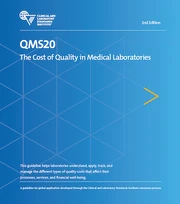You'll receive the latest updates on new standards, guidelines, and educational resources, as well as expert insights to help enhance your laboratory's performance and compliance.
Insights
Explore the latest developments in laboratory standards, guidelines, and best practices. Our expert perspectives and stories provide up-to-date information about what's new in laboratory testing.
All Insights
Filters
{{ sortLabels[option] }}
February 15, 2021
February 12, 2021
January 16, 2021
CLSI welcomes Victor Waddell, PhD, as their new President. Dr. Waddell is the current Director of the Arizona State Public Health Laboratory and Executive Director for the Arizona Biomedical...
January 13, 2021
There has been an enormous increase in the frequency and severity of fungal infections in recent years. Culture from a clinical sample is the gold standard for diagnosis of fungal infection as it has the advantage of yielding the specific etiological agent if positive. Moreover, culture allows for susceptibility testing.
Antimicrobial Susceptibility Testing
AST News
Microbiology
December 10, 2020
Medical laboratory tests are essential to the clinical management of patients. It is important to express numerical results with additional properties, such as linearity.
Method Evaluation
December 6, 2020
Implementing a laboratory quality management system can seem a daunting project. Learn how you can deliver consistent, high-quality, and cost-effective laboratory services by participating CLSI’s updated Laboratory Quality Management System (LQMS) Certificate Program.
November 10, 2020
November 10, 2020
Most laboratories use methods such as QC, equipment calibration measurement, QA measurements of process performance, and more recently, implementation of a quality management system, to determine the quality of examination results and laboratory services.
Quality Management
November 3, 2020
Implementing a quality management system (QMS) can help a laboratory run more efficiently by reducing costs and nonconformances. Most importantly, in the US, a QMS is a requirement under CLIA regulations for passing and maintaining accreditation.
No Results
No results were returned for that query.









